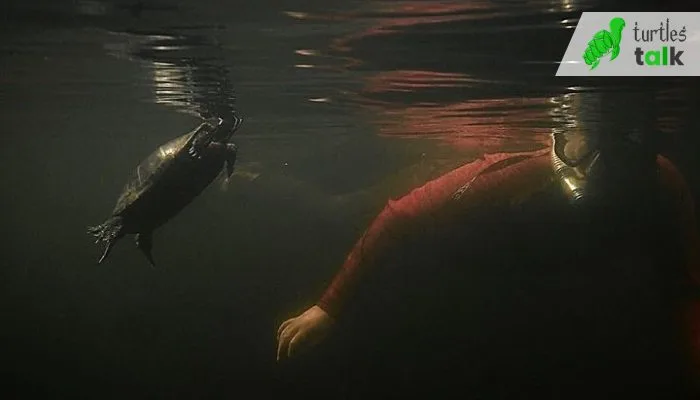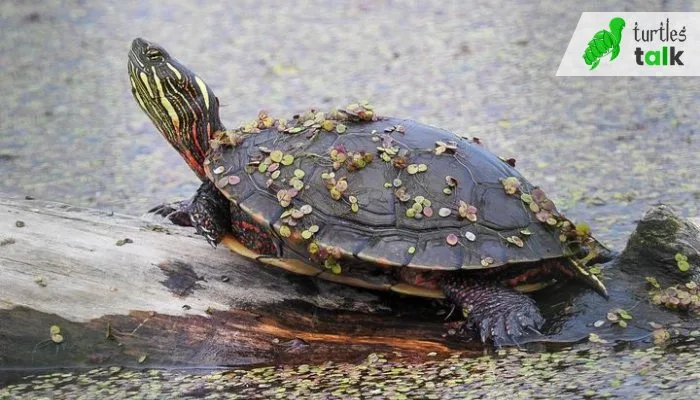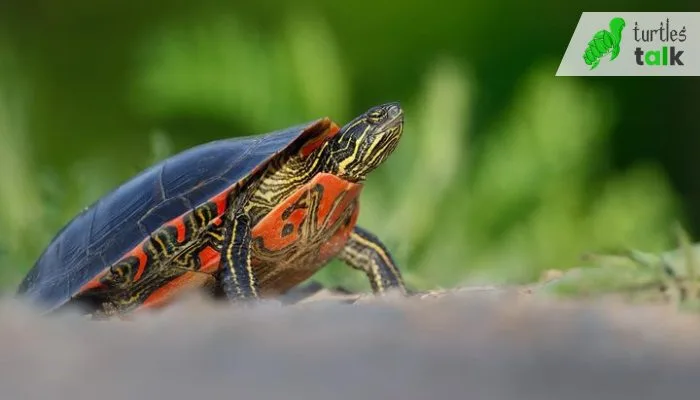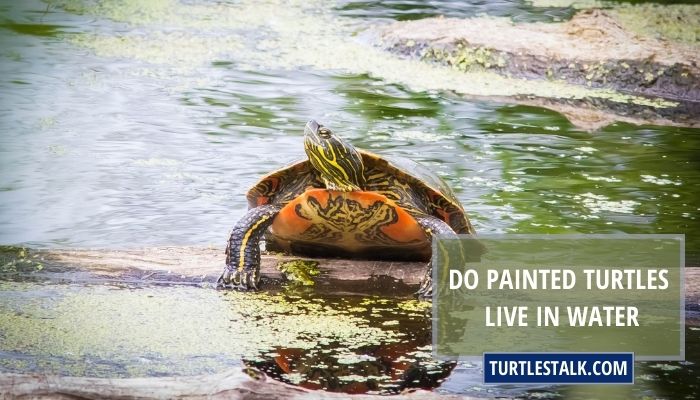Do Painted Turtles Live in Water? (A Complete Guide)
Painted turtles are one of the most common freshwater turtles in North America. These colorful turtles are known for their striking patterns and playful personalities, making them a favorite among turtle enthusiasts. However, one question that often arises is whether painted turtles live in water or on land.
The answer is that painted turtles are primarily aquatic and spend much of their time in the water. They are well-adapted to swimming and diving, with webbed feet and streamlined shells that allow them to move through the water easily. However, painted turtles also need to bask in the sun to regulate their body temperature and dry off their shells, so they also spend some time on land.
In this article, we will explore the aquatic lifestyle of painted turtles in more detail, including their habitat, behavior, and diet. We will also discuss the importance of providing a suitable environment for your pet painted turtle if you’re considering keeping one as a pet.
Are Painted Turtles Aquatic?
Painted turtles are amphibians and live in water. However, they can come onto land to bask in the sun or move between different bodies of water. These reptiles have large heads, carapaces, and flippers designed for swimming. Their bodies are covered in scales that help them swim. Their paddles are strong enough to push them through the water at a fair speed.

One of their most notable characteristics is their love of water. These turtles are aquatic animals that spend most of their time in the water. They are typically found in ponds, lakes, and slow-moving rivers in the wild. They are also commonly found in artificial bodies of water, such as canals and retention ponds.
These turtles are semi-aquatic species, meaning they spend significant time in and out of the water. They are able to survive on land for short periods of time, but they need access to water in order to regulate their body temperature and maintain their overall health properly.
Painted turtles are excellent swimmers and are known for their strong and powerful strokes. They use their webbed feet to propel themselves through the water and their long tails to help them steer. They can also hold their breath for long periods, allowing them to explore deeper parts of their watery habitats.
In captivity, they should be provided with a large enough tank or pond that can accommodate their need for swimming and basking. A good rule of thumb is to provide at least 10 gallons of water per inch of turtle. They will also need a basking area where they can rest and dry off. This can be a small island or a platform that is partially submerged in the water.
What Is the Natural Habitat of a Painted Turtle?
The natural habitat of a painted turtle (Chrysemys picta) is highly varied, as it is found in a wide range of aquatic habitats across a large geographic range. In the United States, they can be found in the eastern and Midwestern regions, and in Canada, they inhabit areas from Nova Scotia to the Yukon.

They prefer habitats with plenty of vegetation, as they use aquatic plants to hide from predators, bask in the sun, and lay eggs. Painted turtles—or painted terrapins—have adapted to living in a variety of natural habitats. Some live in lakes, rivers, or ponds; others live in swampy marshlands.
Some of them may even live in brackish waters—those that are connected to both fresh and salty water. No matter the habitat, these turtles are great swimmers and spend a lot of time in the water.
When not in the water, they usually live in a shallow burrow in the ground—either dug by the turtle or taken over by another animal. These burrows offer protection from predators and keep them warm during winter.
Do Painted Turtles Need to Be in Water?
Painted turtles are semi-aquatic and spend most of their time in the water but will come out to bask in the sun and dry off, too. In captivity, they need a large aquarium or tub filled with water deep enough for them to swim in.
They also need a place to climb out and bask—a flat rock or branch, driftwood, and a hiding spot like a plant or box can provide. Some substrate in the tank or tub will help them feel secure. Aquatic plants—such as water lilies—can be added for decoration and to provide some shade.
Needs in Captivity
When it comes to keeping painted turtles in captivity, it is important to replicate their natural habitat as much as possible. This means that they will need to have access to water at all times. A large aquarium or pond is the best option for housing painted turtles. The water should be deep enough for them to swim and submerge themselves but shallow enough for them to reach the surface for air.
Water Quality
The water in the aquarium or pond should be kept clean and clear. This can be achieved by performing regular water changes and using a filter. It is also important to test the water for pH levels and other parameters to ensure that the water is safe for the turtle to live in.
Basking Area
In addition to water, painted turtles also need a basking area. Provide a basking spot that is warm but not hot, with a heat lamp or—if you can’t use a lamp—an area by the window that’s not in direct sun but still gets some sun. The basking area should be kept at a temperature of around 85 degrees Fahrenheit. This can be achieved by using a heat lamp or a basking bulb.
Diet
Painted turtles are omnivores and will eat a variety of foods in the wild. They can be fed a diet of commercial turtle pellets, vegetables, and fruits in captivity. It is also important to provide them with live or frozen food, such as worms, insects, and small fish.
Offer them fresh water daily and—if possible—offer them food on land. Some people feed their painted turtles lettuce, spinach, and vegetables, but it’s best to stick to an omnivorous diet of aquatic plants and meaty treats such as worms, shrimp, and crickets.
Can Painted Turtles Be Out of Water?
Yes, painted turtles can be out of water for extended periods of time—provided they are properly monitored and kept in suitable conditions. Painted turtles are highly aquatic species and are not well-equipped for terrestrial activity. They have thick bellies and broad feet that function well in water but not on land.

They should always be kept in deep water so they cannot easily climb out. They should also have access to land—whether it be a floating island or a section of bogwood to bask on.
If you properly monitor your turtle, they can be out of water for periods of time—but it is always important to ensure that the environment remains suitable for them and that they cannot escape if given the opportunity.
How to Tell If Your Painted Turtle Is Healthy?
Healthy painted turtles should also have a clean shell with an even color, no cracked or broken plates, and a smooth texture. The skin should be free of dryness, discoloration, raised bumps, and any other abnormalities. If your turtle is healthy, it will have a strong appetite and a healthy weight. It will be active and alert. Its eyes will be clear and bright, and its breathing should be regular and not labored.
It’s important to check your turtle for any signs of illness—such as lethargy or breathing difficulties—and consult a veterinarian if necessary. And don’t forget to check its shell for signs of irregularities or infections, which can be treated with proper turtle medicine. Most importantly, make sure you’re providing the best environment for your turtle to thrive.
How to Clean and Maintain Painted Turtle Shell Health?
Painted Turtle shells require regular care and attention to keep them healthy. Fortunately, you can follow a few easy steps to keep your painted turtle’s shell looking and feeling its best.
Pre-clean the Shell
Before you start any shell cleaning or scrubbing, wipe the turtle’s shell with a damp cloth or paper towel to remove any loose debris or gunk that may have accumulated. Then, rinse the shell with clean water to remove any soap or detergent residue. Also—as with any other pet—ensure that your turtle’s water tank is clean and free of harmful bacteria before introducing it back into the tank.
Use a Mild Soap or Detergent
When cleaning your turtle’s shell, it’s best to use mild soap or detergent to prevent damage to the shell’s natural coating. Apply a small amount of the soap or detergent to a clean cloth and gently scrub the shell in small circular motions. Rinse the shell with clean water and dry it with a soft towel.
Use a Soft Bristled Brush
When scrubbing the shell, it’s best to use a soft-bristled brush. This will help prevent damage to the shell’s natural coating. Apply a small amount of the soap or detergent to the brush and gently scrub the shell in small circular motions. Rinse the shell with clean water and dry with a soft towel.
Repeat as Necessary
Depending on how dirty your turtle’s shell has become, you may need to repeat the cleaning and scrubbing process several times. However, always be careful not to scrub too hard or damage the natural coating of the shell.
And remember to clean your turtle’s tank at least once a week to prevent build-up and improve overall health.
What Are the Proper Living Conditions for Keeping a Painted Turtle as a Pet?
When it comes to keeping painted turtles as pets, providing proper living conditions is crucial. These reptiles need a spacious tank with both land and water areas. The water should be filtered, heated, and deep enough for swimming. A basking area with a UVB light source is essential for their health. Additionally, a varied diet consisting of commercial pellets, leafy greens, and occasional live prey is necessary for their well-being. Regular tank cleaning and monitoring of water parameters are also essential to ensure a healthy and thriving painted turtle.
Conclusion
Painted turtles are an amazing species that are capable of living both in and out of water. They are commonly found in ponds, lakes, and slow-moving waters, and they love to swim.
Their beautiful colors and playful nature make them popular pets, and they are also a great addition to any outdoor pond or water feature. Painted turtles are a great way to add color and life to any aquatic environment.
If you enjoyed this article, leave a comment. Let us know if you liked it. Share it with others. Thanks for reading!

